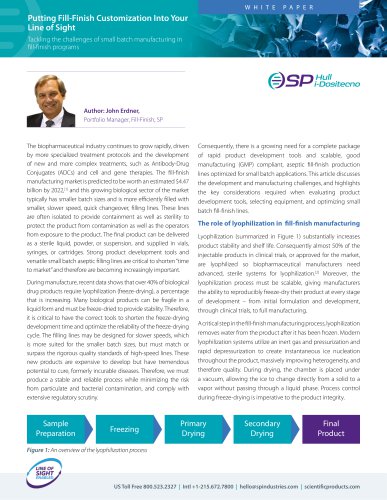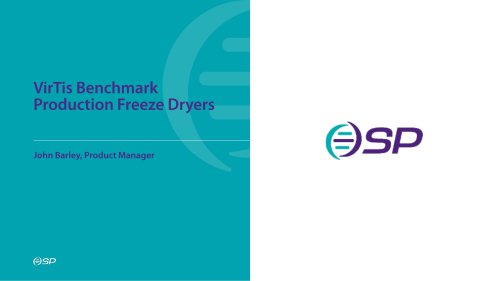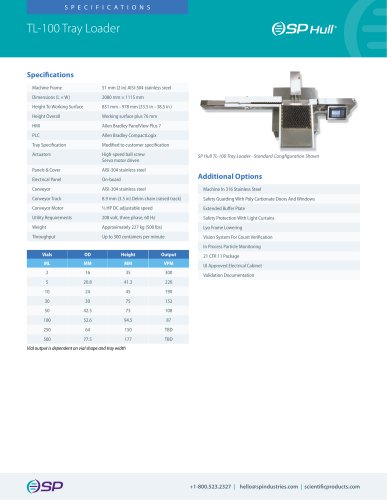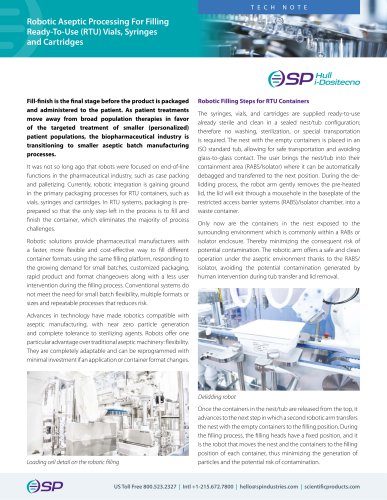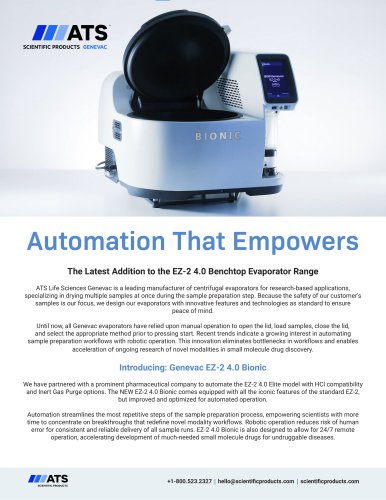
Catalog excerpts
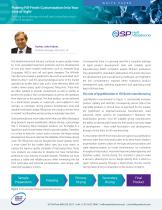
Putting Fill-Finish Customization Into Your Line of Sight Tackling the challenges of small batch manufacturing in fill-finish programs Author: John Erdner, Portfolio Manager, Fill-Finish, SP The biopharmaceutical industry continues to grow rapidly, driven by more specialized treatment protocols and the development of new and more complex treatments, such as Antibody-Drug Conjugates (ADCs) and cell and gene therapies. The fill-finish manufacturing market is predicted to be worth an estimated $4.47 billion by 2022,[1] and this growing biological sector of the market typically has smaller batch sizes and is more efficiently filled with smaller, slower speed, quick changeover, filling lines. These lines are often isolated to provide containment as well as sterility to protect the product from contamination as well as the operators from exposure to the product. The final product can be delivered as a sterile liquid, powder, or suspension, and supplied in vials, syringes, or cartridges. Strong product development tools and versatile small batch aseptic filling lines are critical to shorten “time to market” and therefore are becoming increasingly important. During manufacture, recent data shows that over 40% of biological drug products require lyophilization (freeze-drying), a percentage that is increasing. Many biological products can be fragile in a liquid form and must be freeze-dried to provide stability. Therefore, it is critical to have the correct tools to shorten the freeze-drying development time and optimize the reliability of the freeze-drying cycle. The filling lines may be designed for slower speeds, which is more suited for the smaller batch sizes, but must match or surpass the rigorous quality standards of high-speed lines. These new products are expensive to develop but have tremendous potential to cure, formerly incurable diseases. Therefore, we must produce a stable and reliable process while minimizing the risk from particulate and bacterial contamination, and comply with extensive regulatory scrutiny. Sample Preparation Consequently, there is a growing need for a complete package of rapid product development tools and scalable, good manufacturing (GMP) compliant, aseptic fill-finish production lines optimized for small batch applications. This article discusses the development and manufacturing challenges, and highlights the key considerations required when evaluating product development tools, selecting equipment, and optimizing small batch fill-finish lines. The role of lyophilization in fill-finish manufacturing Lyophilization (summarized in Figure 1) substantially increases product stability and shelf life. Consequently almost 50% of the injectable products in clinical trials, or approved for the market, are lyophilized so biopharmaceutical manufacturers need advanced, sterile systems for lyophilization.[2] Moreover, the lyophilization process must be scalable, giving manufacturers the ability to reproducibly freeze-dry their product at every stage of development – from initial formulation and development, through clinical trials, to full manufacturing. A critical step in the fill-finish manufacturing process, lyophilization removes water from the product after it has been frozen. Modern lyophilization systems utilize an inert gas and pressurization and rapid depressurization to create instantaneous ice nucleation throughout the product, massively improving heterogeneity, and therefore quality. During drying, the chamber is placed under a vacuum, allowing the ice to change directly from a solid to a vapor without passing through a liquid phase. Process control during freeze-drying is imperative to the product integrity. Primary Drying Secondary Drying Final Product Figure 1: An overview of the lyophilization process US Toll Free 800.523.2327 | Intl +1-215.672.7800 | hello@spindustries.com | scientificproducts.
Open the catalog to page 1
Today, fill-finish manufacturing demands scalability and flexibility - especially for small batches of specialized therapies. Small batch manufacturing does not run efficiently and cost-effectively on conventional, larger production lines, therefore necessitating scalable, lyophilization platforms where the product - irrespective of development stage - can be manufactured under sterile, GMP compliant conditions. There are many key challenges throughout the lyophilization process that need to be considered in order to create a consistent, reproducible biopharmaceutical product. For example,...
Open the catalog to page 2
Putting Fill-Finish Customization Into Your Line of Sight Tackling the challenges of small batch manufacturing in fill-finish programs development to full commercial production. ControLyo ensures that every vial, irrespective of scale, shelf location or tray position, experiences the same environmental conditions at the same time. cycle optimization, and manufacturing scale up can be extremely time-consuming and expensive, so it is essential that the fill-finish process is efficient and minimizes product loss. Other Line of Sight PAT tools include LyoFlux® tuneable diode laser absorption...
Open the catalog to page 3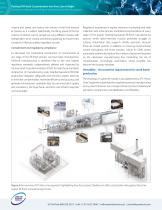
Putting Fill-Finish Customization Into Your Line of Sight Tackling the challenges of small batch manufacturing in fill-finish programs volume and speed, and reduce the velocity of the final amount of solution as it is added. Additionally, the filling speed of the last volume of solution can be carried out using different nozzles with independent servo control, preventing splashing to ensure every container is filled accurately, regardless of scale. Containment and regulatory compliance As discussed, the inadvertent introduction of contaminants at any stage of the fill-finish process can...
Open the catalog to page 4
Putting Fill-Finish Customization Into Your Line of Sight Tackling the challenges of small batch manufacturing in fill-finish programs Smaller footprints As discussed, small batch manufacturing does not run efficiently on standard, higher-speed production lines. Even where changeovers are possible, they are time-consuming and complicated. In contrast, every SP Versa-Line component is compact and has a small footprint to ensure the minimal occupation of cleanroom space. This compactness enables quicker, and more straightforward changeovers during fill-finish production, as, for example, SP’s...
Open the catalog to page 5All SP Scientific Products catalogs and technical brochures
-
virtis Benchmark
18 Pages
-
TL-100 Tray Loader
2 Pages
-
Automation That Empowers
3 Pages
-
LyoStar® 4.0
2 Pages
-
LyoConstellation™ S30
2 Pages
-
LyoConstellation™ S20
2 Pages
-
LyoConstellation™ S10
2 Pages

